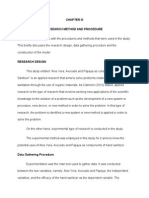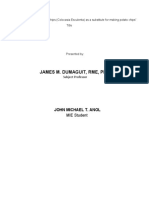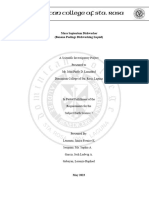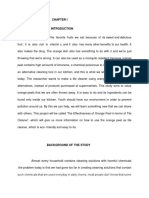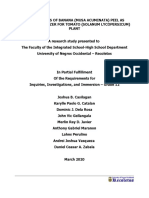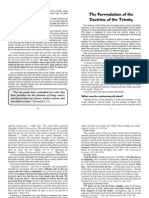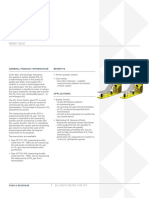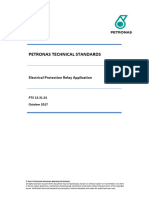Chapter II
Chapter II
Uploaded by
SHeenCopyright:
Available Formats
Chapter II
Chapter II
Uploaded by
SHeenCopyright
Available Formats
Share this document
Did you find this document useful?
Is this content inappropriate?
Copyright:
Available Formats
Chapter II
Chapter II
Uploaded by
SHeenCopyright:
Available Formats
Daniel G.
Hernandez
CHAPTER II
REVIEW OF RELATED LITERATURE
This chapter presents the conceptual and research literature, theoretical and
conceptual framework in the area of Avocado, Papaya and Aloe Veras other benefits
and composition that is pertinent information to the study.
Conceptual Literature
The following topics will be tackled under conceptual literature:
Avocado.This is all about the origin of the word Avocado and its definition.
The word Avocado comes from a Nahuatl Indian (Aztec) word ahucatl
meaning testicle. It is thought that the reference is either due to the avocados shape or
the fact that it was considered to possess aphrodisiac qualities by the Aztecs. In
Spanish, ahucatl became aguacate and eventually avogato and then avocado.
In English, the fruit was first described as an Avagato pear because of its pear-like
shape. Later it also became known as an alligator pear given the alligator-like
appearance to the skin. Over time, the term Avocado became the common word used to
describe the fruit in English.
Avocados are a very healthy type of fruit. One serving, which equals around 1/5 th
of an avocado, is around 50 calories. It has 60% more potassium than a banana and
also contains vitamins B and C. 3/4 of the fruits calories come from fat. But dont worry,
its monounsaturated fat. This type helps lower LDL (low-density lipoprotein), which is
the kind of cholesterol you dont want a lot of. It also is thought to increase HDL (highdensity lipoprotein), which is the kind of cholesterol you do want. Avocados also contain
a high percentage of fiber which helps us all remain regular in our bowel movements!
Fruit Composition. This information is what comprises the avocado.
Daniel G. Hernandez
The protein-content, which has been found to average about 2 per cent, is higher
than that of any other fresh fruit.
The percentage of carbohydrates is not high compared with that of many other
fruits, because the avocado contains almost no sugar. F. B. La Forge of the Bureau of
Chemistry at Washington has found in the avocado a new sugar, called DMannoketoheptose, which is believed to be present in amounts varying from 0.5 to 1
per cent.
The amount of mineral matter is much greater than is found in other fresh fruits.
Soda, potash, magnesium, and lime compose more than one-half the ash or mineral
matter, which places the avocado among the foods which yield an excess of the baseforming elements, as opposed to nuts, which furnish acid-forming elements in excess.
Jaffa 1 says: "So far as protein and ash in fresh fruits are concerned, the
avocado stands at the head of the list, and with reference to the carbohydrates,
contains on an average fully 50 per cent of that found in many fresh fruits. These facts
alone would warrant due consideration being given to the value of the avocado as a
fresh fruit. Its chief value as a food, however, is due to its high content of fat. This
varies, as shown by the analysis, from a minimum of 9.8 per cent to a maximum of 29.1
per cent, with an average of 20.1 per cent. The only fruit comparable with the avocado
in this respect is the olive."
Experiments carried on at the University of California have shown that the
digestibility of avocado fat is equal to that of butter-fat, and not below that of beef fat.
As to the caloric or energy-producing value of the avocado in twenty-eight
varieties examined, one pound of the flesh represents an average of 1000 calories. The
maximum and minimum were 1325 and 597 respectively. The maximum "corresponds
to about 75 per cent of the fuel value of the cereals and is not far from twice that noted
for average lean meat."
Papaya. This is all about the origin of the word Papaya and its definition.
Daniel G. Hernandez
The papaya, Carica papaya L., is a member of the small family Caricaceae allied
to the Passifloraceae. As a dual- or multi-purpose, early-bearing, space-conserving,
herbaceous crop, it is widely acclaimed, despite its susceptibility to natural enemies.
In some parts of the world, especially Australia and some islands of the West
Indies, it is known as papaw, or pawpaw, names which are better limited to the very
different, mainly wild Asimina triloba Dunal, belonging to the Annonaceae. While the
name papaya is widely recognized, it has been corrupted to kapaya, kepaya, lapaya or
tapaya in southern Asia and the East Indies. In French, it is papaye (the fruit) and
papayer (the plant), or sometimes figuier des Iles. Spanish-speaking people employ the
names meln zapote, lechosa, payaya (fruit), papayo or papayero (the plant), fruta
bomba, mamn or mamona, depending on the country. In Brazil, the usual name is
mamao. When first encountered by Europeans it was quite naturally nicknamed "tree
melon".
Commonly and erroneously referred to as a "tree", the plant is properly a large
herb growing at the rate of 6 to 10 ft (1.8-3 m) the first year and reaching 20 or even 30
ft (6-9 m) in height, with a hollow green or deep-purple stem becoming 12 to 16 in (3040 cm) or more thick at the base and roughened by leaf scars. The leaves emerge
directly from the upper part of the stem in a spiral on nearly horizontal petioles 1 to 3 1/2
ft (30-105 cm) long, hollow, succulent, green or more or less dark purple. The blade,
deeply divided into 5 to 9 main segments, each irregularly subdivided, varies from 1 to 2
ft (30-60 cm) in width and has prominent yellowish ribs and veins. The life of a leaf is 4
to 6 months. Both the stem and leaves contain copious white milky latex.
The 5-petalled flowers are fleshy, waxy and slightly fragrant. Some plants bear
only short-stalked pistillate (female) flowers, waxy and ivory-white; or hermaprodite
(perfect) flowers (having female and male organs), ivory-white with bright-yellow anthers
and borne on short stalks; while others may bear only staminate (male) flowers,
clustered on panicles to 5 or 6 ft (1.5-1.8 m) long. There may even be monoecious
plants having both male and female flowers. Some plants at certain seasons produce
short-stalked male flowers, at other times perfect flowers. This change of sex may occur
Daniel G. Hernandez
temporarily during high temperatures in midsummer. Some "all-male" plants
occasionally bear, at the tip of the spray, small flowers with perfect pistils and these
produce abnormally slender fruits. Male or hermaphrodite plants may change
completely to female plants after being beheaded.
Generally, the fruit is melon-like, oval to nearly round, somewhat pyriform, or
elongated club-shaped, 6 to 20 in (15-50 cm) long and 4 to 8 in (10-20 cm) thick;
weighing up to 20 lbs (9 kg). Semi-wild (naturalized) plants bear miniature fruits 1 to 6 in
(2.5-15 cm) long. The skin is waxy and thin but fairly tough. When the fruit is green and
hard it is rich in white latex. As it ripens, it becomes light- or deep-yellow externally and
the thick wall of succulent flesh becomes aromatic, yellow, orange or various shades of
salmon or red. It is then juicy, sweetish and somewhat like a cantaloupe in flavor; in
some types quite musky. Attached lightly to the wall by soft, white, fibrous tissue, are
usually numerous small, black, ovoid, corrugated, peppery seeds about 3/16 in (5 mm)
long, each coated with a transparent, gelatinous aril.
Fruit Composition. This information is what comprises the papaya.
Analysis of the fruit gave moisture 89.6 %, proteins 0.5%, carbohydrate 9.5%m,
ether extract 0.1%, mineral matter 0.4%, calcium 0.01%, phosphorus 0.01%, and iron
0.4 mg/100 gm.The high content of water in the papaya almost as a melon (92%), This
is why some call it the tropical melon.The chemical composition of papaya fruit with
respect to sugars, organic, amino acids, vitamins, and minerals change during
ripening.Most of its carbohydrates are formed from sugars: saccharose, glucose and
fructose.The fresh fruit pulp contains sucrose, invert sugar, a resinous substance,
papain, malic acid and salts of tartaric and citric acids 1.2 per cent.The dry matter which
was 7% at 15 days after pollination, increased to 13% at harvest.Both ripe and unripe
papaya fruit is a rich source of pectins.Papaya is a source of calcium, and an excellent
source of vitamin A and C. The B vitamins are also present in small amounts.Papayas
fruit and seed have been shown to possess bactericidal activity against Staphylococcus
aureus, Bacillus cereus, Escherichia coli, Pseudomonas aeruginosa and Shigella
flexneri.
Daniel G. Hernandez
Aloe Vera. This is all about the origin of the word Aloe Vera and its definition.
Although there are more than 400 species of the Aloe plant growing on the Earth,
it is Aloe Vera or true Aloe, also known scientifically as Aloe Barbadensis Miller, that is
used for its healing and medicinal properties.
Aloe Vera has been used for centuries and early records have shown that the
Egyptians were the first to recognize its unique ability to heal. It is believed that the
therapeutic benefits date back over 4000 years. The very earliest record of Aloe Vera
was found on a Sumerian tablet that dates back to 2100 BC.
Aloe Vera has been used by many cultures throughout the history of the world.
Greek and Roman doctors used it to help heal the ailments of their patients.
Researchers have discovered that the ancient Chinese and Indian cultures benefitted
from the use of Aloe Vera as well.
The Egyptians, and in particular the Egyptian queens such as Cleopatra and
Nefertiti used Aloe Vera as a skincare and beauty product. They believed it gave their
skin a radiant glow and helped to keep them looking young.
In the Philippines, Aloe Vera was mixed with milk and used to treat a variety of
kidney infections. Aloe Vera is referred to as Aloes in the Bible and there are many
biblical references to the healing quality of the plant.
Alexander the Great is documented in history as having used Aloe Vera to treat
his wounded soldiers. This was reputed to have taken place when he conquered the
Island of Socotra in the Indian Ocean. Alexander the Great secured supplies of Aloes
in order to help his men after the battle.
Daniel G. Hernandez
Aloe Vera grew in tropical climates such as in southern Africa and the
Mediterranean. In these areas, it became known as a miracle cure because of its
remarkable healing powers. However due to the more temperate climate of Europe,
many physicians there scoffed at the claims about the healing and therapeutic power of
Aloe Vera. In Europe, Aloe Vera was considered to be a folk remedy that was more of a
myth than a scientific fact.
Aloe Vera continued to be very popular in the tropical areas of the planet. After
World War II came to an end, other parts of the world began to develop a renewed
interest in the plants unique ability to help a number of different medical conditions.
The problem that existed was that there was a need to find ways to prevent the
Aloe Vera gel from deteriorating, as this could happen easily due to excessive heat. It
took many years for this problem to be solved.
Aloin is a part of the Aloe Vera plant that has very strong laxative qualities. It is
the laxative effect of the Aloe Vera plant that propelled it full force into the world of
Western medicine. From there it was researched further and was found to have many
therapeutic benefits.
Today Aloe Vera is used throughout the world for many health conditions. It is
good for the skin, as well as the digestive system, and it can help those suffering from
conditions such as asthma and eczema. Aloe Vera is also helpful for the immune
system in that it gives it an extra jolt to keep it functioning at a high level.
Fruit Composition. This information is what comprises the aloe vera.
Active Components:
Acids: aspartic, glutaminic, aloetic, palmitic, formic and estearic (plant) ascorbic
(leaves) acids.
Essential oils: Cineole, pinene, cariofilene oils.
Daniel G. Hernandez
Minerals:
calcium,
magnesium,
aluminium,
zinc,
phosper,
potassium,
manganese.
Amino acids: aloesin, aloin, arginine, glycine, barbaloin, glutamine, serine,
histidine.
Thiamin.
These active components are present in the fresh leaf. If you do not want the
components to be active, there are stabilized gels available in the market. Look for
details in the label and select the gel that suits your needs.
Chemical Composition
Aloe emodin
Amino acids
Antibiotic principles
Anthraquinones
Arabinose
Emodin
Barbaloin
Glucomannan
Carbohydrates
Galactose
Daniel G. Hernandez
Proteolytic enzymes
Gum
Polysaccharides
Lignin
Rhein
Cathartic anthraglycosides
Saponins
Steroids
Wound healing hormones
Xylose
These chemicals aid in healing, soothing and cleansing actions. These are natural
chemicals that occur in the plant. Nutrient Composition
Aloesin
Chromium
Chloride
Copper
Manganese
Folic Acid
Daniel G. Hernandez
Magnesium
Vitamin B-3
B Complex Vitamins
Vitamin B-12
Zinc
Related Literature
The following researches and studies about Avocado, papaya and Alow Vera as
Sanitizer are to be discussed in the research literature.
The hand plays a very important role in our monotonous life. It is also said to be
the most frequently used organ. However, according to the study of Mwale (2012)
named Sanitation Matters: Health and Hygiene, Focus on Handwashing , human
hands are one of the main transporter of diseases, especially the hands of mothers and
caregivers.
A good hand hygiene will surely help in preventing these diseases.
In the study of Simmone (2013) named Hand Hygiene and Hand Sanitizers ,
the microorganisms from humans and animals is usually transmitted through hands.
This can be solved by alcohol which strip the oil layer of the skin . It also prevents the
fast growth rate of microorganisms on the skin.
However, the study entitled, Hand sanitizers:
Benefits and limitations of
Shuman (2014) states that hand sanitizers are gels that contain alcohol in order to kill
germs present within the skin. Despite its efficacy, alcohol can make the skin dry and it
also cannot cut through grime .
Daniel G. Hernandez
On the other hand, moisture is also needed by the human hands. According to
the study of Marino , MD , MPH (2006) entitled Skin Physiology, Irritants , Dry Skin and
Moisturizers, when the skin is damaged, repair is dependent on retarding the loss of
moisture on the skin.
Synthesis
This part presents the summary of conceptual and research literature, and the
theories presented.
In conceptual literature, the name origin, description and fruit composition of
Avocado, Papaya, and Aloe Vera is included.
The concepts and ideas presented were discussed by Mwale, Simmone,
Shuman Marino , MD MPH. The ideas presented include topics about Skin physiology,
Benefits and limitations of hand sanitizers, and importance of sanitation.
Meanwhile, the studies of Simmone, Marino
and Shulman presented the
antibacterial components and properties of hand sanitizer.
You might also like
- Research Chapter 3Document3 pagesResearch Chapter 3SHeen78% (40)
- TaroStarch FeasibilityStudyDocument142 pagesTaroStarch FeasibilityStudyPatrick SumeguinNo ratings yet
- Design and Develop Taro ChipsDocument13 pagesDesign and Develop Taro ChipsJohnMichaelAnol100% (1)
- DocumentDocument2 pagesDocumentKath Ford0% (1)
- 4 For Laser PrintSCENTED TILES CLEANER OUT FROM MALUNGGAY MORINGA OLEIFERA LEAF EXTRACT 2Document79 pages4 For Laser PrintSCENTED TILES CLEANER OUT FROM MALUNGGAY MORINGA OLEIFERA LEAF EXTRACT 2Gabrielle Alik100% (1)
- Research Camote Hash BrownDocument20 pagesResearch Camote Hash BrownRoma Benavides60% (5)
- Chapter 1Document4 pagesChapter 1MarsNo ratings yet
- Chapter 2Document22 pagesChapter 2Maricar AndresNo ratings yet
- CALABASHBASHDocument30 pagesCALABASHBASHJay AnnNo ratings yet
- Feasibility StudyDocument27 pagesFeasibility StudySunday Gold50% (6)
- GROUP3 EXODUS Introduction To Scope and Limitation. OKRADocument6 pagesGROUP3 EXODUS Introduction To Scope and Limitation. OKRAMaribel Tan-Losloso Nayad0% (1)
- CSU - HM Coconut MuffinDocument20 pagesCSU - HM Coconut MuffinJohanz PacrisNo ratings yet
- Marketing Losses of Pechay Sold in Public Markets in Davao City - Docx 1Document6 pagesMarketing Losses of Pechay Sold in Public Markets in Davao City - Docx 1Ralph Justin II100% (1)
- Eggplant ResearchDocument23 pagesEggplant ResearchRikki Angela VergaraNo ratings yet
- Purposive ResearchDocument8 pagesPurposive ResearchRomulo Rosario Marquez0% (1)
- HRM Research PaperDocument20 pagesHRM Research PaperJames Monsanto100% (1)
- Leaflicious Greencruch KropekDocument20 pagesLeaflicious Greencruch KropekMaryjoy LimNo ratings yet
- The Effectivess of Eggshell As Alterntive Fertilizer To EggplantDocument1 pageThe Effectivess of Eggshell As Alterntive Fertilizer To EggplantJohannah Palconite100% (1)
- The Acceptability of AvocadoDocument14 pagesThe Acceptability of AvocadoJoselito B. Cabello100% (2)
- Presentation For Dry RunDocument17 pagesPresentation For Dry RunJessica Lois TuralbaNo ratings yet
- Chapter 2 RRLDocument3 pagesChapter 2 RRLMaribel Tan-Losloso NayadNo ratings yet
- Acceptability of Mango Puree Enriched Wi PDFDocument9 pagesAcceptability of Mango Puree Enriched Wi PDFLigaya Flamehaze100% (1)
- The Effectivenes of Saluyot Leaves As Antiacne Facial Mask Ingredient'SDocument17 pagesThe Effectivenes of Saluyot Leaves As Antiacne Facial Mask Ingredient'Slordgina100% (1)
- Chapter IvDocument13 pagesChapter IvEnnavy YongkolNo ratings yet
- Pineapple (Ananas Comosus) and Kamias Extract (Averrhoa Bilimbi) As An Alternative Ingredients in Vinegar Making.Document7 pagesPineapple (Ananas Comosus) and Kamias Extract (Averrhoa Bilimbi) As An Alternative Ingredients in Vinegar Making.Amira BronNo ratings yet
- The Cucumber EffectDocument22 pagesThe Cucumber EffectAngeline TancherlaNo ratings yet
- Musa Sapientum Dishwasher Banana Peelings Dishwashing LiquidDocument34 pagesMusa Sapientum Dishwasher Banana Peelings Dishwashing LiquidaestheticfreakingwaterNo ratings yet
- 1-2-3-Chapter ThesisDocument13 pages1-2-3-Chapter ThesisJayson Pizon0% (1)
- Final Thesis 2023Document51 pagesFinal Thesis 2023Aubrey Dacer100% (1)
- Review of Related LiteratureDocument3 pagesReview of Related Literaturemperen91% (11)
- Kalokohan 101Document10 pagesKalokohan 101Jayson PizonNo ratings yet
- Dragon Fruit Peelings As An Additive Ingredient in Making Siomai WrapperDocument29 pagesDragon Fruit Peelings As An Additive Ingredient in Making Siomai Wrapperkarly100% (3)
- Review of LiteratureDocument22 pagesReview of Literaturejavedsaqi64% (11)
- Research SipDocument9 pagesResearch SipSHeen100% (4)
- Saluyot (Sci2)Document8 pagesSaluyot (Sci2)Lina Quintero OdalNo ratings yet
- Effectiveness of Baking SodaDocument22 pagesEffectiveness of Baking SodaMark Anthony Alehandre PegaNo ratings yet
- A Feasibility Study of Chico (Manilkara Zapota) As A New Flavor of WineDocument16 pagesA Feasibility Study of Chico (Manilkara Zapota) As A New Flavor of WineKate BartoloNo ratings yet
- PRDocument11 pagesPRKim Masongsong100% (1)
- Ivy Dela Crus ResearchDocument9 pagesIvy Dela Crus ResearchVon Carlo Tabuan LptNo ratings yet
- Research-Sweetpotatoleaves FINALDocument28 pagesResearch-Sweetpotatoleaves FINALVon Kazer DeañoNo ratings yet
- Development of Pomelo Bar With Shortbread Crust Edited 1Document45 pagesDevelopment of Pomelo Bar With Shortbread Crust Edited 1Jain EpifanioNo ratings yet
- Development Og Rice Flour Into ChipsDocument36 pagesDevelopment Og Rice Flour Into ChipsMika PatocNo ratings yet
- Squash (Cucurbita Pepo L.) Growth and Yield in Response To Different Types of Fertilizers (Farmyard, Chicken Manures, Urea and NPK Granules) PDFDocument112 pagesSquash (Cucurbita Pepo L.) Growth and Yield in Response To Different Types of Fertilizers (Farmyard, Chicken Manures, Urea and NPK Granules) PDFJonabelleVictorianoNo ratings yet
- Basella Alba Flavoured GelatoDocument72 pagesBasella Alba Flavoured GelatoShairamie P. QuiapoNo ratings yet
- Malunggay (Moringa Oleifera) Leaf Extract Can Be Used As An Alternative Treatment For Treating Open Wounds.Document3 pagesMalunggay (Moringa Oleifera) Leaf Extract Can Be Used As An Alternative Treatment For Treating Open Wounds.Elijah Mae MandalunesNo ratings yet
- H.E Proposal Research Avocado FriesDocument8 pagesH.E Proposal Research Avocado FriesMargarito SefilNo ratings yet
- Animal ManureDocument10 pagesAnimal ManureSansen Diamante Colipano Jr.No ratings yet
- Myrtaceae and Is Typically Found in Tropical Countries Such As TheDocument31 pagesMyrtaceae and Is Typically Found in Tropical Countries Such As TheMaiden Gee100% (1)
- Oregano Perfume FinalDocument15 pagesOregano Perfume FinalMarc Neil Cintron100% (1)
- Final SIP Edward Hand SanitizerDocument4 pagesFinal SIP Edward Hand SanitizerJames MartizanoNo ratings yet
- Olitorius) IN SOAP: Martin Lawrence L Asinas John Edison V. Brillo Acel Deane D. CironDocument17 pagesOlitorius) IN SOAP: Martin Lawrence L Asinas John Edison V. Brillo Acel Deane D. CironEllen Joy Velasco BrilloNo ratings yet
- Chapter 1Document9 pagesChapter 1Roxanne MaeNo ratings yet
- Moringa Oleifera Alternative FlourDocument38 pagesMoringa Oleifera Alternative FlourhilaryblancelinsanganNo ratings yet
- ResearchDocument17 pagesResearchNovee Anne LensigNo ratings yet
- CH 1Document13 pagesCH 1Maria Jessa Jabagat PerulinoNo ratings yet
- Background of The Study Statement of ObjectivesDocument4 pagesBackground of The Study Statement of ObjectivesEudelyn MelchorNo ratings yet
- The Effects of Orange Research Autosaved RevisedDocument23 pagesThe Effects of Orange Research Autosaved Revisedmaikadjim60% (10)
- Papaya Ice Cream AMERICADocument8 pagesPapaya Ice Cream AMERICAAbbygale RosalNo ratings yet
- Review of Related Literature: Daniel G. HernandezDocument10 pagesReview of Related Literature: Daniel G. HernandezYvannah BasanesNo ratings yet
- PERSEA AMERICANA Mill. Laurus Persea Linn. Persea Gratissima Gaertn.Document2 pagesPERSEA AMERICANA Mill. Laurus Persea Linn. Persea Gratissima Gaertn.dniesse_asisNo ratings yet
- Kadapa BananaDocument21 pagesKadapa BananaChandrasekhar ReddypemmakaNo ratings yet
- Research SipDocument9 pagesResearch SipSHeen100% (4)
- How To Practice Preferential Option For The PoorDocument17 pagesHow To Practice Preferential Option For The PoorSHeenNo ratings yet
- SinigangDocument1 pageSinigangSHeenNo ratings yet
- Autodesk AutoCAD Civil 3D 2015 Certification Roadmap v2Document2 pagesAutodesk AutoCAD Civil 3D 2015 Certification Roadmap v2Ahmad ThaherNo ratings yet
- Solving Linear Equations 2Document1 pageSolving Linear Equations 2Tomato CHNo ratings yet
- The Formulation of The Doctrine of The Trinity by Lynnford BeachyDocument12 pagesThe Formulation of The Doctrine of The Trinity by Lynnford Beachyberean2No ratings yet
- Unit Test 1B: 2 Points For Each Correct AnswerDocument2 pagesUnit Test 1B: 2 Points For Each Correct AnswerFrctybzNo ratings yet
- OCIF-lista de Concesionarios Transferencias Monetarias PDFDocument4 pagesOCIF-lista de Concesionarios Transferencias Monetarias PDFTecnetico.comNo ratings yet
- Haffmans CPT: CO Purity TesterDocument2 pagesHaffmans CPT: CO Purity Testermouh niaNo ratings yet
- Module 8Document12 pagesModule 8Suzanne GaranNo ratings yet
- NewsRecord14 01 22Document12 pagesNewsRecord14 01 22Kristina HicksNo ratings yet
- Shoulder Pain and Disability Index Spadi1 PDFDocument2 pagesShoulder Pain and Disability Index Spadi1 PDFnurNo ratings yet
- Descriptive TextDocument1 pageDescriptive TextDharWin d'Wing-Wing d'AriestBoyzNo ratings yet
- Erythroblastic SynartesisDocument11 pagesErythroblastic SynartesisKata TölgyesiNo ratings yet
- Capital Budgeting Decision Criteria: 2002, Prentice Hall, IncDocument59 pagesCapital Budgeting Decision Criteria: 2002, Prentice Hall, IncMarselinus Aditya Hartanto TjungadiNo ratings yet
- Academic Calendar Enen 2023 2024Document3 pagesAcademic Calendar Enen 2023 2024Yousef AbuhejlehNo ratings yet
- Soal Kelas 8 New JawabanDocument3 pagesSoal Kelas 8 New Jawabandaniel7chillgoNo ratings yet
- 7-Naskah Soal - PASDocument4 pages7-Naskah Soal - PASRirin NurainiNo ratings yet
- VR80 - Schema ElettricoDocument89 pagesVR80 - Schema Elettricoson nguyen dangNo ratings yet
- Electrical Protection Relay ApplicationDocument62 pagesElectrical Protection Relay Applicationjk.jackycheokNo ratings yet
- Bird Photography: Etiquette: PhotzyDocument15 pagesBird Photography: Etiquette: PhotzymrpiracyNo ratings yet
- 01 Siain Enterprises Inc. vs. F.F. Cruz & Co., G.R. No. 146616, August 31, 2006Document6 pages01 Siain Enterprises Inc. vs. F.F. Cruz & Co., G.R. No. 146616, August 31, 2006Andrei Da JoseNo ratings yet
- Esparza v. State of Utah, 10th Cir. (2007)Document5 pagesEsparza v. State of Utah, 10th Cir. (2007)Scribd Government DocsNo ratings yet
- History of Ancient 01 Walt U of TDocument640 pagesHistory of Ancient 01 Walt U of TBranko NikolicNo ratings yet
- Br2e Adv Readingfile12Document2 pagesBr2e Adv Readingfile12PressCall AcademyNo ratings yet
- What Do You Mean by Burglary Insurance?Document5 pagesWhat Do You Mean by Burglary Insurance?pkbrarNo ratings yet
- Dr. Mehreen Chida-Razvi: Perception and Reality: The Mughal City of Lahore Through European EyesDocument10 pagesDr. Mehreen Chida-Razvi: Perception and Reality: The Mughal City of Lahore Through European EyesTariq Maqsood KhanNo ratings yet
- DEDsetia 20150902bctqi3Document41 pagesDEDsetia 20150902bctqi3mhudzzNo ratings yet
- Elements of A Short StoryDocument3 pagesElements of A Short StoryKans SisonNo ratings yet
- Track ConsignmentDocument2 pagesTrack ConsignmentGD CONSULTANCYNo ratings yet
- Tle CSS Module 5 - Terminating and Connecting Electrical Wiring and Electronic CircuitDocument21 pagesTle CSS Module 5 - Terminating and Connecting Electrical Wiring and Electronic CircuitCrauxz de TraxNo ratings yet
- Ppe AssignmentDocument3 pagesPpe AssignmentHarsh PatleNo ratings yet
- Review Novel EverythingDocument4 pagesReview Novel EverythingTiafana Aqil IkhsanNo ratings yet
